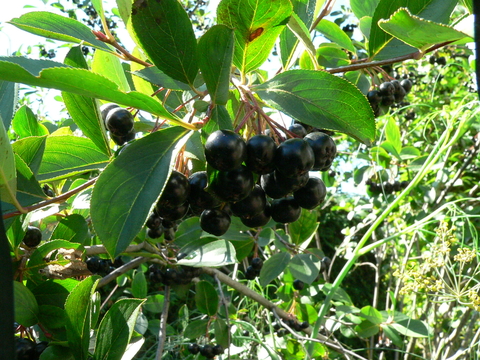Quick facts
- A buffer is a strip of trees, shrubs, grasses or other plants that helps protect water from runoff and stabilize shorelines.
- The Minnesota Buffer Law requires landowners to have perennial vegetation buffers of up to 50 feet along lakes, rivers, streams and ditches.
- Consider planting a buffer that provides economic or environmental benefits, such as pollinator-friendly grasses and plants, fruit and nut trees, or decorative woody florals.
- You can rent the buffer to another farmer.
Making the most of your buffers
A buffer is a strip of trees, shrubs, grasses or other plants that helps protect water from runoff and stabilize shorelines.
Minnesota law requires landowners to have up to 50 feet of buffer along waterways such as rivers, lakes, streams and ditches.
Buffers can provide economic or environmental benefits. Note that some cost-share programs may not allow you to sell products from the buffer if it is still under the terms of the contract.
Beneficial plants for your buffer
Pollinator-friendly plants and grasses
- By planting seed mixes of pollinator-friendly grasses and plants such as clover, sunflower, daylily and milkweed, buffers can offer habitat and food to native bees and wasps, including honey bees.
- There may be specific pollinator planting grants and cost-share programs available.
- In the fall, you could also harvest and sell seed to generate income from the buffer.
- Learn more with these pollinator conservation resources.
Native seed
Native forage and grass seed is always a valuable commodity. You could plant buffers to native species that are in high demand. You are allowed to harvest these seeds in late summer and fall, as long as you do not disturb the planting.
Fruits and nuts
Elderberry
Elderberry is becoming more well-known as a health food, juice and wine supplement. The Midwest Elderberry Cooperative helps members sell their elderberries for value-added products.
Bushes are usually spaced in rows 10 feet apart and 4 to 6 feet within the row.
University of Missouri Extension Center for Agroforestry has partnered with Missouri elderberry growers to create a comprehensive guide on growing elderberry.
Black chokeberry or aronia berry
Black chokeberry or aronia berry is becoming very popular as a health food, thanks to its high antioxidant levels. Shrubs can be grown in the backyard and as a field planting. They are usually spaced in rows 10 feet apart and 4 to 6 feet apart within the row.
Learn more about aronia berry in the Midwest.
Hazelnut
Hazelnuts are popular as edible nuts and may offer value-added products, such as nut butter and oil. However, most hybrid hazelnuts lack consistency and each plant has different characteristics. Research trials are underway to develop methods for selecting and propagating the best plants for growers.
Plants are usually spaced in rows 10 feet apart and 4 to 6 feet apart within the row.
Learn more about hazelnuts in the Upper Midwest.
Decorative woody florals
Woody florals are any wood plant, mainly shrubs, that can be made into decorative arrangements either by the grower or a flower business. Plants include curly willows, dogwoods, pussy willows and many more. Stems are usually harvested each year, depending on the plant.
Learn more in this grower’s guide to producing woody floral stems.
Other productive buffer options
Blackberry.
Perennial intermediate wheatgrass.
Renting buffers
You can also earn money by renting your buffers to another farmer. Examples of renters may be:
A beef or dairy producer who rents a forage or grass buffer to bale hay for winter feed.
A beginning farmer who rents the buffer to plant black chokeberry (aronia berry) shrubs to process berries into products like juices and jams.
Read about farm lease arrangements.
The Minnesota Buffer Law
All public bodies of water within the state must have adjacent buffers. The law defines a buffer as an area that:
- Consists of perennial vegetation, excluding invasive plants and noxious weeds.
- Protects the state’s water resources from runoff pollution.
- Stabilizes soils, shores and banks.
- Protects or provides riparian corridors, which are plant communities that grow near natural bodies of water.
The Minnesota Buffer Law requires landowners to have perennial vegetation buffers of up to 50 feet along lakes, rivers, streams and ditches. These buffers will help filter out phosphorus, nitrogen and sediment.
The Minnesota Buffer Law began November 1, 2017 for public waters and November 1, 2018 for public drainage systems.
Signed by Governor Mark Dayton in the summer of 2015, this law aims to improve water quality by requiring buffer strips on an estimated 110,000 acres of land statewide.
The Minnesota Board of Water and Soil Resources (BWSR) is the lead agency for implementing the Minnesota Buffer Law.
County Soil and Water Conservation Districts (SWCDs) are the local contact agency for farmers and landowners.
If you are a landowner with any part of your parcel within 50 feet of a DNR-designated Public Water Basin or Public Watercourse, or within 16.5 feet of a Public Ditch, then the Buffer Law applies to you.
The law provides flexibility and financial support so landowners can install and maintain buffers, and boosts compliance with buffer laws across Minnesota.
Alternative practices (other than buffers) may be accepted if they improve water quality.
Measure buffer widths from the top or crown of the bank. Where there ia no defined bank, measure from the edge of the normal water level.
- Public waters: 50-foot average buffer width with a 30-foot minimum width.
- Public ditches: 16.5-foot minimum width.
Reviewed in 2018




